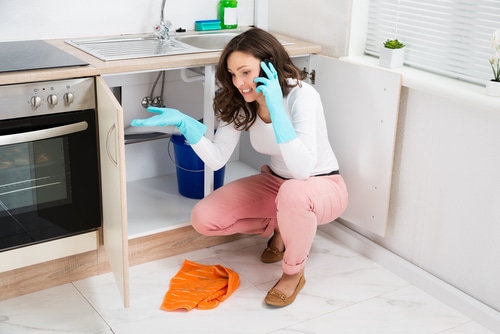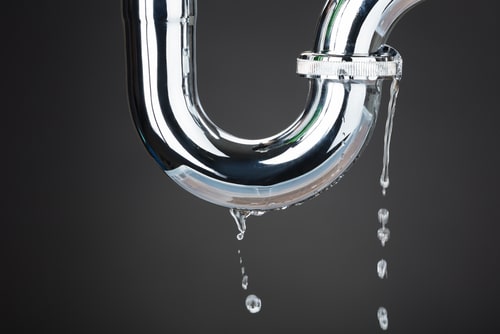Water Leaks: Where and Why Do They Commonly Occur?
If you are a homeowner, it is essential to know the potential causes of water leaks, as well as where they can occur in order to try and prevent water leaks from happening. However, sometimes it is not possible to prevent a water leak from occurring so it becomes important to recognize signs of water leaks in order to mitigate potential damage as soon as possible. Also, insurance doesn’t cover all types of water leaks, especially those that cause damage due to a homeowner’s neglect of not taking immediate action to avoid or stop water loss quickly.
That is why prevention is always the first line of defense against water leaks, and part of your preventive efforts is learning more about the most common reasons for water leaks, as well as their usual locations. So, here is some valuable information to minimize the need to call leak detection experts from Riverside.
 What could cause a water leak?
What could cause a water leak?
When it comes to water leaks, there can be many potential reasons behind them. However, in the majority of households, the following 5 potential causes of water leaks stand out as the most frequent:
- Foundation shifts: The foundations of your home settle over time, which can cause your water and drain lines to rupture or disconnect.
- High water pressure: Excessively high water pressure running through the pipes and fixtures of your home will lead to early deterioration of your plumbing systems and may cause pipe bursts, leaks and malfunctioning toilets, shut-off valves, water heaters, etc.
- Tree roots: Pipes can develop tiny cracks that allow vapor to escape and allow tree roots to burrow into your piping, causing significant damage. This is most common with sewer drain lines that remove water and waste from your home, since they run underground through the front yard. Over time, root infestation will clog drains and cause water to backflow into the house.
- Corrosion: Pipes don’t have an unlimited life span. Houses built before 1975 were most likely plumbed with galvanized pipes which are prone to becoming rusted and corroded, making them susceptible to leaks and bursts.
- Temperature fluctuations: Extreme temperature changes that mostly occur when the weather is cold can lead to your pipe cracking and leaking.
Where do most water leaks occur?
Believe it or not, there are many possible sources for water leaks in the home, and not all of them would be the first thought for a homeowner not familiar with the nuances of water leaks. Let’s take a look at the 6 most common places for water leaks in your home.
Washing machines
Your washing machine is one of the appliances that uses the most water, and it connects to two pressurized water lines in your home via supply line hoses and valves. As long as the washing machine is working properly, homeowners do not think about checking or replacing these hoses or valves as a part of routine house maintenance until there is a sudden rupture.
Because older hoses are manufactured from polymer or black rubber, they deteriorate over time and can cause unnoticed water damage over a period of time.
Newer washing machine hoses are made of stainless steel improved materials but can still burst at the seams so it is still good to keep your washing machine valves and hoses visible and replace them when they start to look worn.
Water haters
Water heater tanks can rupture when they fall prey to corrosion and rust, and when they simply reach the end of their life expectancy. The water heater tank may either start leaking in small drips, or it may rupture and cause a sudden burst of water to flood the area and cause an urgent response.
If your water heater has been installed in a drip pan (which it should be), take a look at it regularly to make sure no water is in the pan. You can also purchase a water leak detection device that can sit in the pan and warn you if water gets in the pan.
This is good for small leaks only. To prevent a tank rupture, be proactive and replace the water heater every 8-12 years, as well as, take measures to routinely test and prevent excessive thermal expansion by keeping the home’s water pressure level within the safe operating range of 50psi-75psi, and installing a water heater expansion tank if necessary.
Toilets
Toilet leaks can come from many sources. Pressurized toilet leaks typically originate either in the tank or from the external water supply line that extends from the wall to the toilet’s fill valve. A leak that can cause severe damage and even fast mold growth is if there is an issue with the wax ring or the flange that causes toilet waste and water to seep onto the floor and ceiling.
While we are mostly referring to pressurized water lines in this post, old toilets that no longer flush well may cause toilet stoppages that overflow into the home. If your toilet is having flush power issues, it may be time to replace internal components or the entire toilet.
Dishwashers and refrigerators
Refrigerator ice makers or water dispensers within your refrigerator can always instigate a rupture or a leak because they are connected to a pressurized water source. Dishwashers, even if not used at all, or rarely, can develop leaks from supply lines and shut-off valves which are located behind the unit.
Left unnoticed, small leaks over time can cause substantial damage to your flooring, cabinets and walls. It is a good idea to check the condition of all the plumbing under your kitchen sink every few months, as well as, place leak detection devices in critical areas. They are inexpensive and could save thousands if you catch the leak quickly!
Sinks and showers
Showers, as well as sinks, have water supply lines located in the wall, which can make leaks from these sources very difficult to notice until damage is already done. Worn-out grout/caulking is another source of water leakage from showers and tubs. A simple grout/caulking tune up on worn out areas may be all that is needed to avoid water from seeping through to adjoining walls, or a downstairs ceiling.
HVAC equipment
If there is a clog in the drain lines, the AC condensate pan will overflow, causing excess moisture to gather and moisten the area, creating problems in the drywalls. It’s important to know where your AC drains and check the drain line, refrigerant, and condensate pump annually before seasonal use.

Who offers premium leak detection services in Riverside?
Water leaks are serious problems that can cause significant damage to your property if left unattended for even the shortest periods of time. That is why it is important to know what can cause them and where they most frequently occur and then to react immediately if you do notice water leaking in your home.
You can always rely on OneStop Plumbers to help you resolve your water leak problems promptly, efficiency, and adequately. We cater to all the residents of Riverside and the surrounding areas, so it doesn’t matter if you live in Castle Park or at another location. Our quality leak detection technicians are available to help you out. Contact us today!
